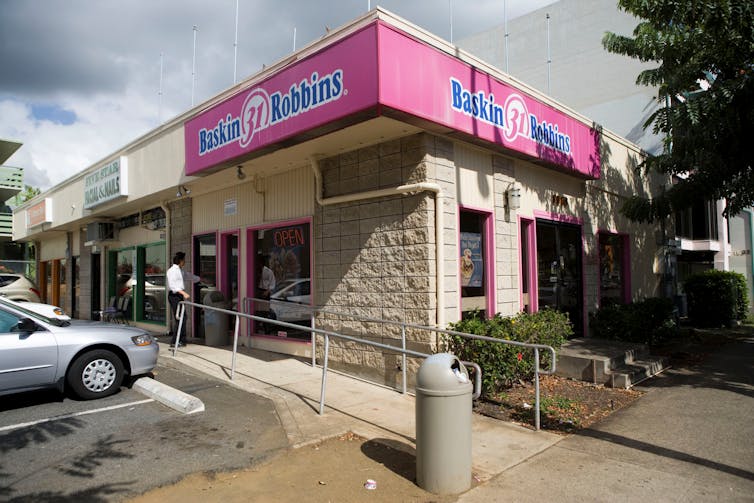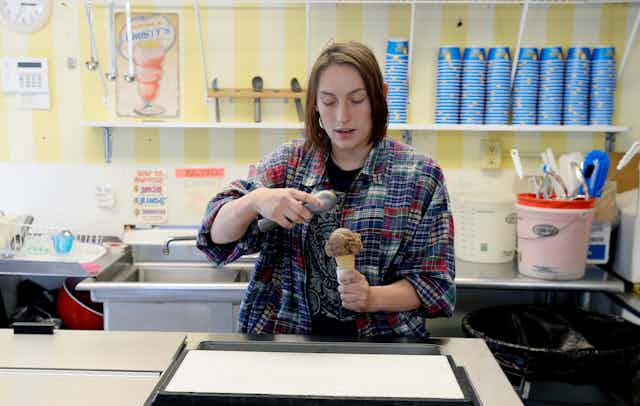Think about your first job. Maybe it was delivering pizza, bagging groceries, busing tables or doing landscaping work. Did you get enough training to avoid potential injuries? Chances are, you didn’t – and your boss or supervisor just told you to get to work.
Employing young people helps them in many ways. They can learn a trade, develop job skills, become more responsible and earn money. But there’s danger, too: Americans between 15 and 24 years old are up to 2.3 times more likely to get injured on the job than workers who are 25 and over.
In 2021, 398 workers under 25 died after getting injured on the job.
In my research about the unique occupational safety hazards young workers face, I’ve identified three common causes of this susceptibility to injury: their lack of experience, developing bodies and brains, and reluctance to speak up.
Physical and cognitive limitations
The 19 million young people employed today make up approximately 13% of the U.S. workforce.
Work is more dangerous for young people because they’ve simply had less time to become aware of many common workplace hazards than their older co-workers.
And yet this problem isn’t typically addressed during onboarding: Even those who have been trained to do a specific job may not be taught ways to avoid common injuries. These include tendinitis from scooping ice cream for hours on end, burns from operating a deep fryer, lacerations from sharp objects, and slips, trips and falls.
It’s also important to remember that bodies and brains continue to develop well into adulthood – up to age 25. This can make some tasks riskier before that point for the 55% of individuals between the ages of 16 and 24 who work.
For example, workers in their teens and early 20s may be smaller and weaker than older workers. Furthermore, some safety equipment, such as gloves and masks, may not properly fit.
In addition to physical changes that occur during adolescence, the brain is also developing and restructuring into early adulthood. The frontal cortex, which is used for decision-making and helps you to think before you act, continues to develop into adulthood and can lead to risky behaviors.
Young people are inclined to seek approval and respect, which influences their decision-making.
They also engage in risky behaviors both on and off the job that may affect their performance at work.
Finally, many young workers are reluctant to speak up if they have concerns, or to ask questions if they don’t know what to do, because they don’t want to lose respect from their boss or supervisor. To avoid appearing unqualified, they may not want to admit that they need help.

Weaker protections in some states
Despite these inherent risks, Arkansas, Iowa and other states have recently weakened labor laws, loosening restrictions about the kinds of work teens can do and increasing the number of hours they can work.
This is happening at a time when the number of child labor violations are rising and more children are dying or getting injured, especially when they do tasks that violate federal labor laws.
Duvan Tomas Perez, for example, died on the job while cleaning machinery in the Mar-Jac Poultry plant in Hattiesburg, Mississippi, in August 2023. Perez was 16. So was Michael Schuls, who died in June 2023 while attempting to unjam a wood-stacking machine at Florence Hardwoods, a Wisconsin lumber company. Will Hampton, another 16-year-old, also died that month in Lee’s Summit, Missouri, while working at a landfill.
Teachers at a Nebraska middle school figured out that students who had trouble staying awake at school were working night shifts at a slaughterhouse, doing dangerous cleaning work that caused chemical burns.
Enacted in 1938, the Fair Labor Standards Act established federal standards to ensure workplace safety for workers under 18 and bars employers from interfering with their educational opportunities. This law sets 14 as a minimum age for formal employment, restricts when and how many hours children may work, and outlines the type of work children may safely perform.
Some of the new state labor laws allow children to work in more dangerous jobs and limit their employers’ liability for injury, illness or even death on the job.
When state labor laws are less restrictive than the federal law, however, the federal standards apply.
The federal government is also ramping up enforcement efforts. The Labor Department found 4,474 children employed in violation of federal child labor laws between Oct. 1, 2022, and July 20, 2023. Employers, including McDonald’s and Sonic fast-food franchisees, owed more than $6.6 million in penalties as a result.
3 steps employers can take
In addition to following the law, I believe that employers and supervisors need to address the unique risks to young workers by taking these necessary steps:
• Provide training on how to do tasks safely and supervise young workers until key tasks have been mastered. Training should not only occur right before a new employee gets ready for their first shift, but whenever new tasks are assigned, when there is a new hazard in the workplace, and after an injury or near miss occurs in the workplace.
• Model safe behaviors. Remember that young workers often learn by watching their bosses and co-workers, whose actions can reinforce safety expectations and build a culture of safety.
• Take into account a worker’s abilities when assigning tasks, and check in on them regularly, especially when switching tasks. Ask open-ended questions, such as, “What are the steps you are going to take when you do this task?” as opposed to questions that can be answered with a yes or no, like, “Do you know how to do this task?” Be sure to let workers know how to report concerns and who they can talk to if they have questions about workplace procedures and policies.
These strategies are easy to implement and cost little to follow.
And they surely make it safer for workers in their teens and early 20s to gain the valuable work experience they want and need, while helping their employers to maintain safe, productive workplaces that nurture the workers our economy will increasingly depend upon in the years ahead.

